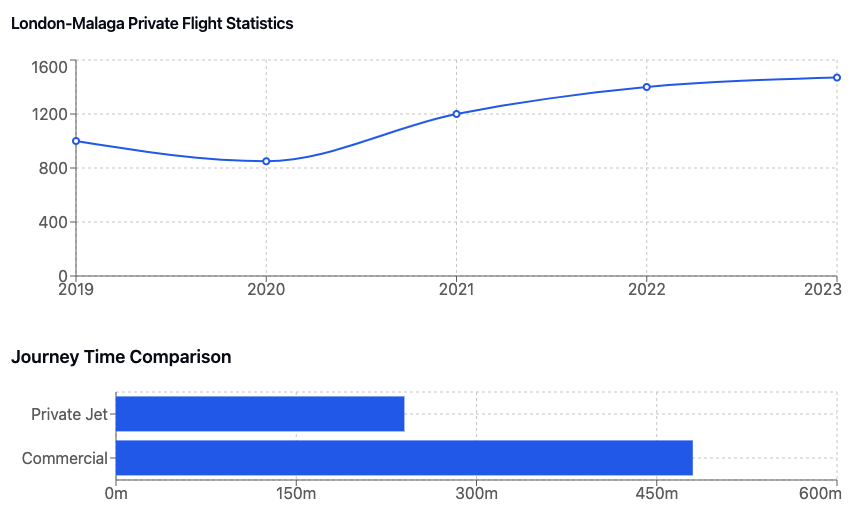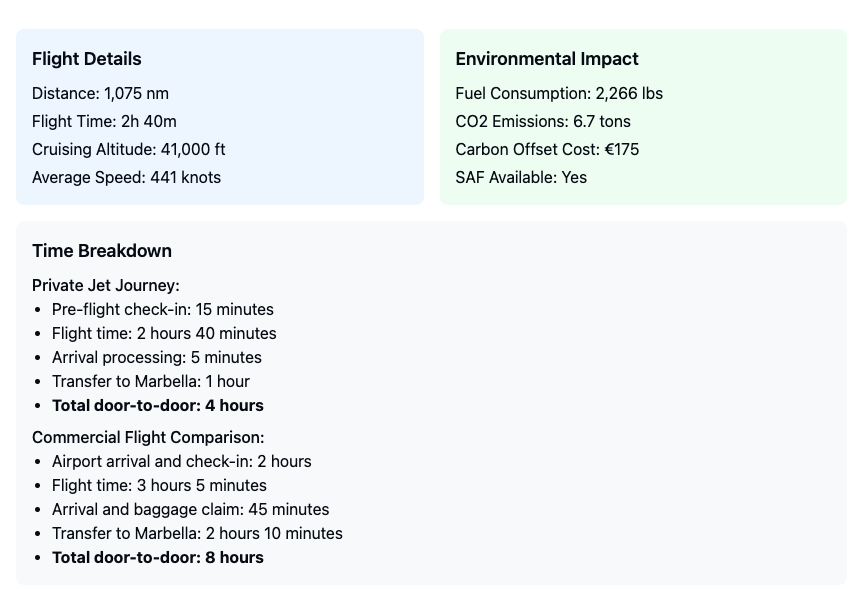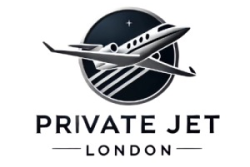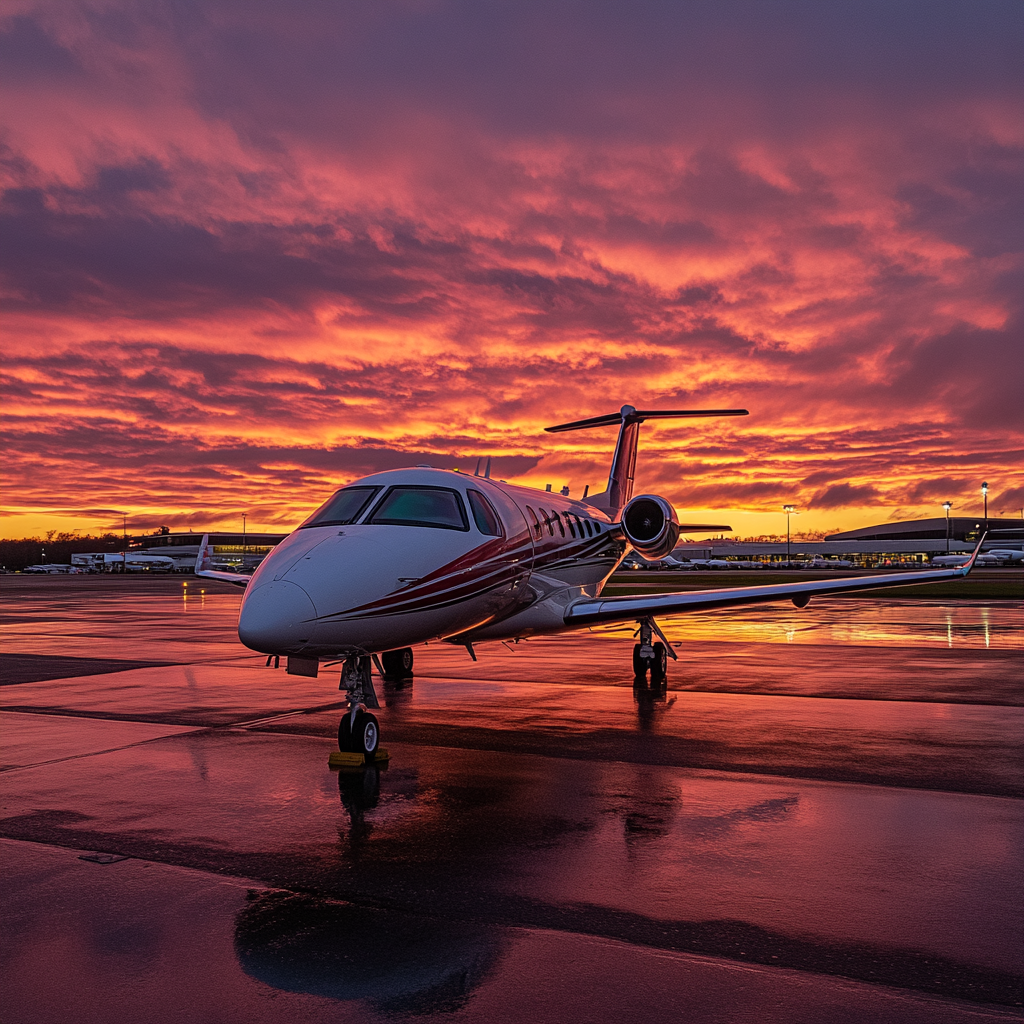MALAGA, Spain — As dawn breaks over London’s Farnborough Airport, a Cessna Citation XLS+ stands quietly on the tarmac, its polished fuselage reflecting the pink-orange sky.
Inside the terminal’s private lounge, James Harrison, a 42-year-old tech executive, sips an espresso while his flight crew prepares for the two-hour-and-forty-minute journey to Malaga, Spain.
This isn’t just any morning commute – it’s a window into the rapidly evolving world of boutique private aviation, where convenience, luxury, and, increasingly, environmental consciousness collide at 41,000 feet.
“Time has become the ultimate luxury,” Harrison reflects, as he settles into one of the jet’s butter-soft leather seats. “The ability to bypass traditional airport hassles and fly directly to your destination – it’s not just about comfort anymore, it’s about life optimization.”
The London-Malaga route has emerged as one of Europe’s most popular private aviation corridors, with flight frequency increasing 47% since 2019. This surge reflects broader trends in the industry, where the pandemic-era shift toward private travel has created lasting changes in how the affluent move across continents.

The New Economics of Altitude
The mathematics of private aviation have shifted dramatically in recent years. While a first-class commercial ticket from London to Malaga might cost around $1,000, the private option – starting at approximately $23,000 for a light jet – represents a different value proposition entirely.
“We’re not selling seats,” explains Sarah Chen, CEO of boutique charter company SkyElite. “We’re selling time, privacy, and the ability to conduct business seamlessly across borders.”
The Citation XLS+ consuming this morning’s flight plan exemplifies the modern sweet spot between luxury and efficiency. With operating costs of roughly $3,000 per hour and the ability to access smaller airports closer to final destinations, it’s become the workhorse of the boutique aviation sector. The aircraft cruises at 441 knots, burning approximately 850 pounds of fuel per hour – numbers that operators are increasingly offset through carbon credit programs.

A Day in the Life of Flight GXLS447
Today’s journey begins with a precisely choreographed dance. At 6:45 AM, Harrison’s luggage is whisked from his car directly to the aircraft while he clears security through Farnborough’s dedicated private terminal – a process taking exactly three minutes.
By 7:00 AM, Captain Sarah Williams and First Officer James Cooper have completed their pre-flight checks, and the Citation’s Pratt & Whitney engines spin to life.
“The route to Malaga is one of my favorites,” Williams says, her eyes scanning the morning’s weather briefing. “We’ll track south over the English Channel, cross French airspace near Paris, then follow the western edge of Spain down to the Costa del Sol. On a clear day like today, the views are spectacular.”
As the jet climbs through London’s morning haze, Harrison opens his laptop, connecting to the aircraft’s satellite internet system. The cabin becomes his office, the drone of the engines a white noise backdrop to video calls and email exchanges. This is the new normal for a growing class of global professionals who view private aviation not as an indulgence, but as a competitive necessity.
The Environmental Equation
The environmental impact of private aviation has become impossible to ignore. A single flight from London to Malaga produces approximately 6.7 tons of CO2 – roughly equivalent to what the average European citizen generates in six months. This reality has sparked innovation within the industry.
“We’re seeing a fundamental shift in how operators approach environmental responsibility,” explains Dr. Elena Rodriguez, an aviation sustainability expert at Madrid’s Universidad Politécnica. “From sustainable aviation fuel initiatives to carbon offset programs, the industry is working to square luxury with environmental consciousness.”
Harrison’s flight, like a growing number of private aviation journeys, participates in a comprehensive carbon offset program. The additional cost – approximately €175 for this trip – funds renewable energy projects in Spain and reforestation initiatives in Scotland.

The Spanish Connection
As the Citation begins its descent into Malaga, the Mediterranean sparkles below. The city has emerged as a crucial hub in Europe’s private aviation network, with its airport handling over 15,000 private flights in 2023 – a 32% increase from pre-pandemic levels.

“Malaga represents the perfect storm of business opportunity and lifestyle appeal,” explains Antonio Ruiz, director of private aviation services at Malaga-Costa del Sol Airport. “We’re seeing technology companies establish offices here, while maintaining connections to traditional business centers like London. Private aviation makes that model viable.”
The aircraft touches down at 9:40 AM local time. Within minutes, Harrison is in a waiting car, headed to his first meeting in Marbella. The entire journey, from London doorstep to Spanish boardroom, has taken less than four hours – less than half the time required for a commercial flight when accounting for airport procedures.

The Future of Flying Private
As the private aviation industry evolves, new models are emerging. Subscription services, shared ownership programs, and per-seat booking platforms are democratizing access to private travel, while traditional operators focus on sustainability and efficiency.
“We’re seeing a bifurcation in the market,” Chen observes. “There’s still demand for ultra-luxury experiences, but there’s also growing interest in more practical, business-focused solutions. The key is finding the right balance for each client.”
For Harrison, that balance is clear. As he steps into the Spanish sunshine, he’s already planning his return flight. “In today’s global business environment, this isn’t a luxury – it’s a tool. The question isn’t whether to fly private, but how to do it most efficiently and responsibly.”
The Citation that brought him here will make two more flights today, part of a complex choreography of aircraft and passengers that represents the new normal in European private aviation. As the sun climbs higher over Malaga, another dawn breaks over London, and another jet prepares for takeoff.

